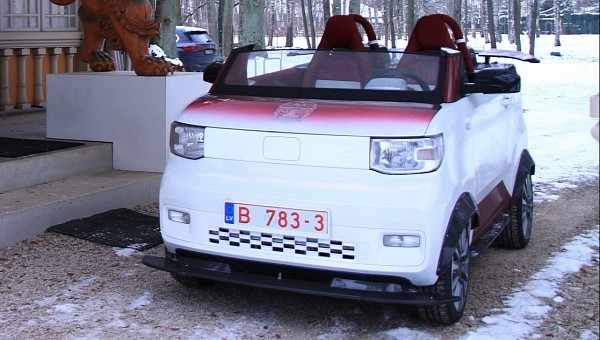For a company that was recently brought back from the dead, FreZe has a lot of stories to tell. From its original idea of selling the affordable Wuling Hongguang Mini EV in Europe, it went through a partnership breakup and an entirely new project: the FreZe Froggy EV Beachstar. When we last spoke to Leonard Yankelovich, he was willing to sell both the brand and the project. The company just announced that it happened.
Using the Moke and the Meyers Manx as examples, DARTZ disclosed that it sold FreZe and its tiny electric roadster project to an unidentified investor. The Latvian company did not reveal how much money was involved in the transaction or the plans the new FreZe owner had for the company and its first modern product.
As you might remember, FreZe was a Russian brand founded by Pyotr Aleksandrovich Frese. Its first vehicle was an electric car presented in 1896. It was the first automobile created in Russia and had the name Jakowlew & Frese. That was due to the company’s other founder, Yevgeny Alexandrowitsch Jakowlew. The first car, named solely Frese, emerged in 1902, but its independent career lasted only eight years. In 1910, RBVZ purchased Frese & Co. If you did not connect the name to the “person,” RBVZ is the company that gave birth to DARTZ.
When we last spoke to Yankelovich, he said he brought FreZe back to life after getting tired of turning down proposals to sell his leading company. Anyone willing to have a piece of DARTZ could buy FreZe instead. While DARTZ has sold around 50 vehicles in 20 years of activities, FreZe already delivered around 100 units of the rebadged Mini EV to fleet and private customers in Europe.
The FreZe Froggy EV Beachstar project was developed in the Old Continent. The idea consisted of modifying a Wuling Hongguang Mini EV to turn it into a roadster. Yankelovich said that any Chinese vehicle could be transformed into the Beachstar, pointing to other options apart from the Wuling. Considering how many competitors the Mini EV currently has in the Chinese market, it should not be difficult to choose one.
We are trying to contact Yankelovich to discover how much money the deal involved and also what the new FreZe owner plans to do with the brand and with the Froggy EV Beachstar. The Latvian entrepreneur wanted to sell it to resorts and fancy hotels as vehicles for its guests to move around. Either the investor who bought FreZe had the same vision, or they may try something else.
The Citroën Ami success in Europe proves there is room for affordable electric quadricycles in Europe. While they may prefer something stylish like the Microlino, there seems to be room for something like the Mini EV and its competitors. Let’s wait and see what Yankelovich and the new FreZe owners can share with us.
As you might remember, FreZe was a Russian brand founded by Pyotr Aleksandrovich Frese. Its first vehicle was an electric car presented in 1896. It was the first automobile created in Russia and had the name Jakowlew & Frese. That was due to the company’s other founder, Yevgeny Alexandrowitsch Jakowlew. The first car, named solely Frese, emerged in 1902, but its independent career lasted only eight years. In 1910, RBVZ purchased Frese & Co. If you did not connect the name to the “person,” RBVZ is the company that gave birth to DARTZ.
When we last spoke to Yankelovich, he said he brought FreZe back to life after getting tired of turning down proposals to sell his leading company. Anyone willing to have a piece of DARTZ could buy FreZe instead. While DARTZ has sold around 50 vehicles in 20 years of activities, FreZe already delivered around 100 units of the rebadged Mini EV to fleet and private customers in Europe.
The FreZe Froggy EV Beachstar project was developed in the Old Continent. The idea consisted of modifying a Wuling Hongguang Mini EV to turn it into a roadster. Yankelovich said that any Chinese vehicle could be transformed into the Beachstar, pointing to other options apart from the Wuling. Considering how many competitors the Mini EV currently has in the Chinese market, it should not be difficult to choose one.
We are trying to contact Yankelovich to discover how much money the deal involved and also what the new FreZe owner plans to do with the brand and with the Froggy EV Beachstar. The Latvian entrepreneur wanted to sell it to resorts and fancy hotels as vehicles for its guests to move around. Either the investor who bought FreZe had the same vision, or they may try something else.
The Citroën Ami success in Europe proves there is room for affordable electric quadricycles in Europe. While they may prefer something stylish like the Microlino, there seems to be room for something like the Mini EV and its competitors. Let’s wait and see what Yankelovich and the new FreZe owners can share with us.










